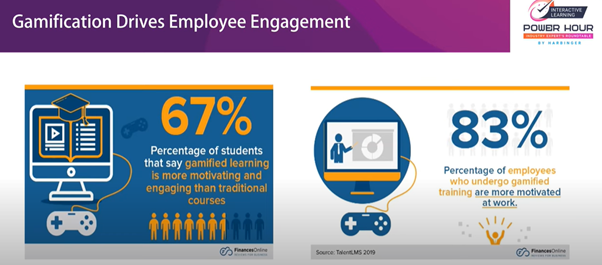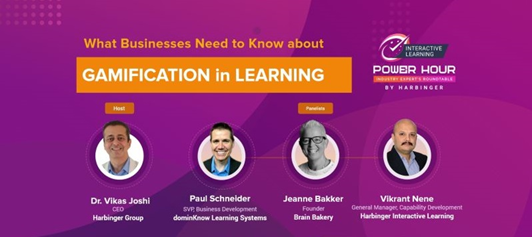
Before we begin to explore gamification to improve employee engagement, it would be good to first understand the difference between gamification and game-based learning. This will help us to understand why gamification strategies are beneficial for employee engagement.
Gamification v/s Game-based learning
Is gamification the same as learning games? The answer is no. There are two things – game-based learning and gamification – that have some overlaps and hence are often confused.
Game-based learning is a type of active learning experience within a game framework. It takes your core content and objectives and presents these in a game experience, making it fun. Think about the popular show ‘Who Wants to be a Millionaire’ or ‘Jeopardy!’.
In this scenario, you are playing a game and within the content of the game, you are learning something new. You learn new concepts and practice skills in a risk-free setting. It is a fun experience for all those involved. The progress of the game is directly related to your understanding of the subject or your skill.
In fact, one of the key things about game-based learning is that it is known to have a significant impact on retention and recall.
Gamification, on the other hand, is the process of adding game elements or mechanics to a learning experience. Think of points, badges, leaderboards, progress bars, levels, incentives, and other such game mechanics elements. Gamification is about adding these elements, or components, to the content to drive motivation.
Thus, it can be as simple as adding levels or progress bars to the existing content. Or it can also be more complex like giving points or creating leaderboards for employees.
Gamification to improve employee engagement
So, where does gamification fit in the organizational picture of employee engagement? To answer that question, we must look at the top priorities of corporate L&D and which among them is the topmost.
According to a recent Brandon Hall research study titled ‘State of Learning Practices: Creating a Learning Strategy for the Future of Work,’ 74% of L&D professionals would consider creating a stronger link between learning and performance as their top priority for the next 12 months. That priority splits into two dimensions or key metrics – learner engagement and business outcomes.
There are many different learning modalities such as teaching, coaching, videos, and eLearning, and they all achieve varying levels of engagement and business outcomes. For example, real classroom learning may have one level of effectiveness compared to sending out ready coursework to the learners.
Interestingly, the same research by Brandon Hall tried to find out the engagement level for different modalities such as instructor-led classrooms, microlearning, learner-created content, videos, and so on. The results showed that for eLearning modules, the engagement is only 38% effective.
Is there a possibility then that gamification can help here? Can gamification be the answer to increase the learning effectiveness and in turn, assist employee engagement?
The answer is yes. Gamification does have a positive effect on engagement. Several studies have proved that employees who undergo gamified training are more motivated at work. This means that if businesses opt for gamified content, say, for example, for training purposes, there is a significant impact on employee engagement and in turn, the business outcomes.

Gamification strategies
A survey by TalentLMS states that 83% of employees who received gamified training feel motivated, while 61% of employees who received non-gamified training feel bored and unproductive.
Some common applications of gamification are onboarding, product innovation, elimination of employee errors, collaboration, wellness programs, and so on. The main use of gamification is to foster engagement to drive motivation.
People have these human needs for collecting, competing, and succeeding. And gamification thrives on that. This is the value of gamification. It takes your current content, it doesn’t have to redo it in a game format, it’s the same content but you have elements that introduce motivation and therefore make it more desirable from an engagement perspective.
Gamification is one of the most promising ways of elevating employee experience and creating impactful learning. How does this happen? By creating engaging learning experiences, gamification enables organizations to increase learning retention, motivate employees, and drive employee engagement.
Harbinger’s gamified instructional solution has helped multiple organizations deliver effective business results using a variety of authoring tools like Storyline, Captivate, dominKnow, HTML5, and more. The company’s award-winning gamification framework allows organizations to add gamification elements to eLearning rapidly in a cost-effective way.
The fully customizable framework makes it extremely easy for any organization to add a layer of gamification to any type of learning content and quickly develop varied learning experiences. It includes personalized learning delivery based on performance, scenario-based learning, integration with gamified LMS, and more. We suggest you read this blog for the common questions on implementing gamification for employee engagement.
But to generally provide a quick outlook on how you can introduce gamification at the workplace, think of recruitment function and training purposes. You can have points-based quizzes, social recognition, scorecards, or rewards and badges. Such strategies make it easier for employees to copy positive behaviors, thus creating an encouraging workplace atmosphere.
Amazon is an example where employees at their various warehouses can gamify their workload. The game works together with their facility technology to track employee work progress, which is then compared to other employees. Virtual badges are then given to employees as incentives. Such initiatives are even more significant for the current remote and disparate workforce to provide them a feeling of working together as a team.
Gamification for achieving business objectives

Harbinger recently hosted a Power Hour on ‘What Businesses Need to Know about Gamification in Learning’ with industry experts Paul Schneider, SVP – Business Development, dominKnow; Jeanne Bakker, Founder of Brain Bakery; and Vikrant Nene, General Manager – Capability Development, Harbinger Interactive Learning. This webinar was hosted by Dr. Vikas Joshi, CEO of Harbinger Group.
It was a highly interactive session where the panelists shared their own experiences in designing gamified content for different business needs, including employee engagement.
Over the years, businesses are opting for this proactive approach to build employee engagement and achieve productivity and performance gains. If you too are considering gamification for your organization, write to us at contact@harbingergroup.com. to learn about our customized solutions.






